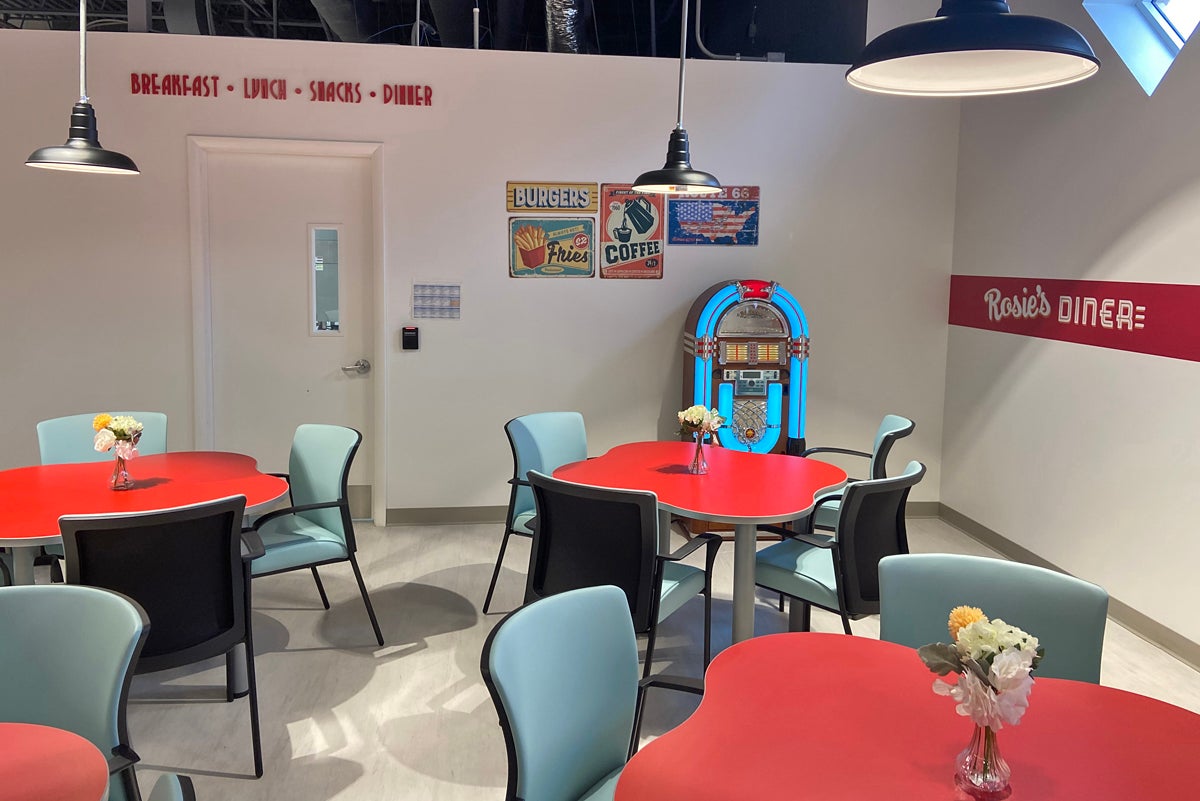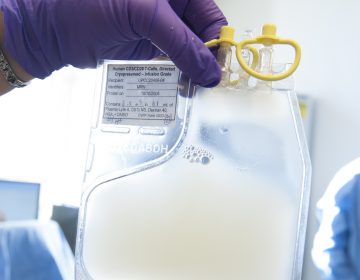Recalling the past, in hopes of triggering better life in the present
Reminiscence therapy helps jog a sense of the former self, for those who’ve lost parts of who they are today.
Listen 7:26
A ’55 Bel Air is one of the first things you see at Town Square, an adult day care center in Baltimore, that’s designed like the 1950s to bring out old memories as a form of reminiscence therapy. (Lecia Bushak/For WHYY)
This story is from The Pulse, a weekly health and science podcast.
Subscribe on Apple Podcasts, Stitcher or wherever you get your podcasts.
It feels like I’ve stepped onto a movie set — or maybe I’m in a time warp. I’m at Town Square, an adult day care facility in Baltimore, and it looks like an indoor replica of an American town in the 1950s.
There’s Rosie’s diner, and a movie theater with pictures of Elvis Presley on the wall. Storefronts with vintage auto-repair posters, and furniture that looks like it could be from an antiques store — or from my grandma’s basement.
Perhaps the biggest attention-grabber is the shiny blue Chevy with white-rimmed tires, a boxy frame, and a sleek white roof.
“When people walk through that door and see that car, the ’55 Bel Air, it’s like automatic: They click,” said Megahn Rineman, the activities manager at Town Square. “You just see it in their eyes, you see it in their face, they’re just awakened.”
Rineman develops programs here that help bring back old memories for people with dementia.
“They’ll start talking about, ‘Oh, I had one just like this,’ or ‘My dad had one just like this, we took so many trips in this,’” Rineman said. “And even the smell, the smell inside the car, triggers people.”
This is all part of something known as reminiscence therapy. Town Square serves people with dementia and Alzheimer’s — they come here to spend the day. And being here seems to ”spark” memories for them.
Sometimes, those memories come back through visual cues, like old Life magazines posted up on a newsstand featuring covers with John F. Kennedy. Or through sounds, like a jukebox in the diner that plays swing tunes.

Often, it’s through programs in which staff members try to jog memories through pictures, books or conversations. In one room, reading a book about animals sparks a decades-old memory for one member.
“My husband would come to bed, and he’d go to sleep, and the dog would crawl right over my husband to get in between the two of us,” the member recalled. “He said, ‘What ran over me?’ I said, ‘The dog.’”
How exactly does reminiscence therapy work?
Alzheimer’s disease damages parts of the brain, which leads to memory loss. But more and more, researchers are beginning to believe that memories aren’t fully lost or destroyed — rather, that some are just hidden and need to be coaxed out.
Some of this relates to the difference between short-term and long-term memory. Arjun Masurkar is a neurologist at New York University. He said short-term memories tend to be stored in the hippocampus, while longer-term memories are tucked away in a variety of different brain regions.
“The hippocampus, being essential for remembering what we did yesterday and a week ago, it’s just very vulnerable to destruction by Alzheimer’s disease, but also by brain trauma and stroke,” Masurkar said. “Whereas for some reason, the brain structures that are associated with long-term memories are implicitly, intrinsically, very strong, very robust. Maybe there’s a lot of sharing of the network, in terms of how that information is stored.”
Tapping into memory’s networks
Short-term memories are often the first to be damaged or destroyed when Alzheimer’s develops. But the brain builds complex networks around memories, and they’re often stored in a lot of different brain regions.
That’s also why we shouldn’t assume “memory loss” means all memories are gone forever, said Steven Sabat, a neuropsychologist at Georgetown University.
“The networks that are involved with important events are tremendous,” Sabat said. “It’s less likely that you could poke a hole in one part of the brain and destroy the entire memory itself.”
He said there’s memory, and then there are roads in the brain to access those memories.
“So it’s really difficult to destroy memory per se, much easier to destroy a person’s ability to gain access to it,” Sabat said.
Alzheimer’s may affect the roads more than the memory itself, though researchers are still exploring how to differentiate between the two on brain scans.
“There are other structures in the brain that are involved in memory too, and that’s why implicit functions are still possible, even though there’s hippocampus damage,” Sabat added.
What adds to the strength of some of these complex networks, especially with older or more emotional memories, is the fact that the brain can actually build new roads to access those memories where past ones have been destroyed — and this is where reminiscence therapy comes in.
Masurkar said there is some evidence that when typical routes to access memories may be impaired, those memories can still be “triggered” by new or different routes.
“There’s probably a secondary mechanism, a road so to speak, that allows that long-term memory to then be brought into our attention, into our focus,” Masurkar said. “It’s probably damage of those roads, or that process, that kind of is an interruption or short-circuit, so you’re not able to jog that memory out in your typical means. And then with therapy, like reminiscence therapy, you may be finding alternative pathways to jog out that memory.”
Jogging out that memory may be possible through visuals, like that shiny blue Chevy at Town Square, or through smells and music.
“You hear a song and you remember what was happening in your life when you heard that song, and you get the feeling — you can recall the feeling of that time,” Sabat said.
“For me it’s `Livin’ on a Prayer’ by Bon Jovi,” said Christy Turner, a dementia-care specialist in Portland, Oregon. When she hears that song, “Boom, I’m 17 again, and all of the sights and sounds and experiences of being 17 [come back] … that’s why music is so important.”
She said reminiscence therapy is about drawing out that positive feeling — a feeling that stays with you even when the specific memory can’t be recalled.
“A sense of self, a sense of feeling anchored into who they are right now, not feeling sort of untethered,” she said.
And studies have shown that reminiscence therapy can help reduce anxiety and agitation.
“Another benefit from reminiscence therapy is also helping people connect back to times when they showed great resilience, and celebrating their accomplishments again,” Turner said.
At Town Square, Rineman, the activities director, said that’s what they’re trying to hone in on.
“We have a gentleman that comes in and plays the piano, plays older songs,” she said. “After he left, one of our members just got to the piano and started playing. She hasn’t played in a very, very long time. And when she was done, we were like, ‘Hey, we didn’t know you played piano,’ and she was like, ‘I don’t know how to play piano.’ But she was there, in that moment, and her body just knew what to do.”
Rineman said those are the moments their hoping to achieve.
“To bring them back to what they used to be, even if it’s just for a couple seconds.”
WHYY is your source for fact-based, in-depth journalism and information. As a nonprofit organization, we rely on financial support from readers like you. Please give today.






